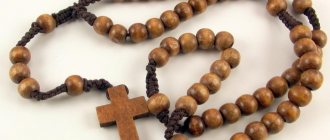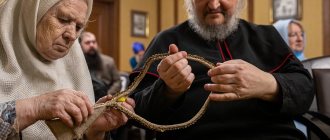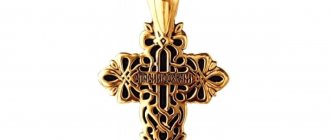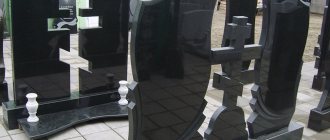- Ancient Orthodox rosary: ladder and ladder
- Modern Orthodox rosary: vervitsa
- Number of beads in Orthodox rosaries
- Prayers with Orthodox rosary
- Features of choosing Orthodox rosaries
Nothing helps you focus on prayer like having a rosary. For example, saying the prayer words to the Mother of God 150 times, it is easier to sort through the beads than to keep count in your head. This is a great way to take your mind off the hustle and bustle and get away from idle thoughts. Therefore, the use of rosaries is common among believers, whose active prayer life is impossible without them. For Christian monks, rosaries played the role of “spiritual swords,” while Orthodox laypeople used them to call on God for help and salvation.
Is this for monks or lay people?
The rosary is a purely monastic attribute, like a military uniform: jacket, shoulder straps, and so on. This is what monks have: hood, mantle, rosary, cross, paraman. Monasticism arose in the 4th-5th centuries after the Nativity of Christ as a result of the cessation of persecution of the Church from without and its emergence within - sects, schisms, disorder, and so on. People had a thirst for seeking an ascetic life for the sake of the Lord. Therefore, the rosary is such a spiritual sword, a reminder that monks are prayer books for the whole world. This is an integral part of even the appearance of monastics, an object that has not only practical, but also a certain symbolic meaning.
As for the laity, probably every experienced priest has encountered the problem when new believers strive to conform to some monastic stereotypes. Especially men: they have a desire to grow a beard and long hair, take a blessing on their rosary, and use them demonstratively during church services. We must immediately warn you that in this case there is a high probability of error and the wrong path. The manifestation of one’s aspirations and spiritual exercises is alarming. A person, without realizing it, can fall into delusion, a false self-image, conceit, pride, vanity, and so on.
Rosary shape
Modern rosary is a closed thread consisting of small “grains”, divided into dozens of larger “grains”. The most common number of “grains” is 50 or 100. Monastic rosaries sometimes contain 1000.
In ancient times in Rus', the rosary had a different shape - a closed ladder consisting of wooden blocks covered with leather or fabric. They were called “ladder” or “lestovka” (ladder) and spiritually designated the ladder of salvation, ascent to heaven. The closure of the rosary and rosary means unceasing, eternal prayer.
Can? Yes, but there are questions.
When people ask me whether they can use rosaries when praying, I usually ask: why would you count the number of prayers? Usually they answer me that there are monastic rules - the Pentecostal, the Centpentecostal, the Theotokos Rule. I understand that people now are all literate, they look at the Internet, read books with monastic content - and then apply all this in their lives. When answering, I try to delicately ask the person: do you read morning and evening prayers, the Holy Scriptures of the New Testament - every day? At least one or two chapters? Holy Fathers - after lunch, when your strength is no longer the same, your attention becomes dull?
If, after all of the above, you have the strength and time for prayer beyond that, you want to fulfill the monastic rule - God will help you. Take the rosary for as many links as you have - ten, thirty, one hundred - and read the Jesus Prayer. There are many interpretations of it, in the Greek tradition there are only five words in it: “Lord Jesus Christ, have mercy on me.” There may be options when the words “Lord Jesus Christ, Son of God, have mercy on me” are added; according to Seraphim of Sarov, “through the prayers of the Mother of God, have mercy on me” is added. The most important rule is to put your mind into the words of prayer and maintain attention.
What makes this prayer interesting, attractive and great is that it is very short, it is good to keep your attention on it, but it is very meaningful, can teach you a lot, save you from a lot and help in many moments of your spiritual life.
Description of the Orthodox rosary Vervitsa
Vervitsa comes from the Old Russian word “verv”, which means rope. These are the so-called Orthodox wicker rosaries. Outwardly, they resemble a rope with a certain number of knots tied on it. Traditionally, such rosaries are made from silk soutache and wool.
There is an original way to weave rope knots. They begin to weave from left to right. After the required number of knots has been obtained, the circle is closed with a round knot so that the “tails” of this cord remain visible. Then three more knots are made on these tails, to the ends of which a cross purchased in the temple is attached. The resulting rope is then sprinkled with holy water three times. In addition to the unique method of making rosaries, the process itself is accompanied by prayers. Before starting, they say a prayer to the Lord, the Mother of God, and after completing the weaving of the rope, it is also consecrated with prayer.
But there is another version of the rope. It is a thread on which beads are strung, closed in a circle. This form of rosary speaks of a person’s endless and continuous prayer, which helps to direct him directly to God. Each subsequent ten beads is separated from the previous one by a cross or a bead of a different size. The ends of the lace are connected into a knot. In Orthodox rosaries, the ends are decorated with a cross with a tassel and a cry. This decoration serves as a reminder to the Christian of the importance of keeping God's commandments. Vervitsa beads can be made of glass, plastic, ivory or natural stones. In the modern world, ropes are very popular among Orthodox believers. They became widely used in the Moscow Patriarchate. The Monk Sergius of Radonezh himself used them during prayers.
Beware of hypocrisy and delusion
I would like to warn our laity against Pharisaism, because it is very easy to turn into a person who “increases the opening of the vestments,” as the Savior says, denouncing Pharisaic vanity and pride. “But you, when you pray, go into your room and, having shut your door, pray to your Father who is in secret; and your Father, who sees in secret, will reward you openly” (Matthew 8:8). Read the Jesus Prayer, use the rosary, but don’t show it to others. There is a tradition of falling asleep with a rosary, when a person reads the Jesus Prayer before going to bed - this is very good. There is no need to take long rosaries, take the smallest ones, on your finger, and read.
I would really like to encourage believers who use rosaries: there is no need to count prayers or do arithmetic. “I read 150 yesterday, today I’ll read 250!” - this is not a sport. When this starts, you are very afraid for the person. It's not about arithmetic. St. Ignatius Brianchaninov, St. Barsanuphius of Optina and other holy fathers write very competently about this. They teach: you don’t need to engage in prayer, you need to pray to it. This is a living appeal to the living God. But one must be very careful with spiritual exploits.
Saint Ignatius has the following example: an ascetic came to him who did not experience hunger, and in winter he walked in one cassock and did not sleep for days. The saint asked: “How do you, dear one, pray?” He told, and the saint asked him to pray, as the holy fathers teach. A week later, the ascetic came in upset feelings with the question: “What have you done to me?!” He developed a huge appetite, he began to feel cold, and could not wake up in the morning. That is, the demon of vanity helped him, and when that monk began not to engage in prayer, but to pray, the demon moved away from the words of the Jesus Prayer, as if from fire, and everything changed. We need to tell the laity about this and warn them.
Let me emphasize: all of the above does not apply to monks. They have their own life, they obey the established rules, fulfill the blessing of the abbot and live according to obedience. In the world, you need to be very careful with your spiritual load.
Video on the topic
What are Orthodox rosary beads for? Answer in video:
Orthodox rosary is a powerful religious attribute that helps a person strengthen his connection with God, remember to read prayers and focus on them. You need to purchase rosaries with full responsibility and not use them for other purposes.
Rosary beads should not be perceived as decoration, since they have a certain energy charge. Passing rosary beads to another person, giving your own and accepting someone else’s is extremely dangerous.
An alternative to the usual rule
In the world, probably every priest has heard complaints from parishioners that they do not perceive morning and evening prayers - a person knows them so well, he is so used to them that attention is already dulled. The believer understands that he is simply reading the rule, and many at this moment even give up praying. There is a practice: replacing morning and evening prayers with the Jesus Prayer. There are ten to fifteen minutes - take your rosary, stand and pray. You can also read the Psalter as much as you have time - two psalms, and maybe two kathismas. Then you will have a new text every time, and even if you read in a circle, these texts will not have time to become boring. This relieves the psyche, trains attention, a reboot occurs, and you can pray like this for a month or two. After all, the traditional rule is a conditional thing, and, from the point of view of history, it was compiled recently.
Kinds
In Orthodoxy there are three types of rosaries:
- ropes;
- stairs;
- ladders
Lestovki are the oldest type of Orthodox rosary and are literally translated as “ladder.” The lestovka has little in common with the current rosary and is a belt lined with bobbin loops. They are arranged in a certain way, and in the end the belt really resembles a ladder.
The edges of the belt are sewn up with triangles called paws. The hollow loops are filled with small paper rolls on which various prayers are written. Lestovki in our time are used only by Old Believers, but you can see them with your own eyes in many museums.
The ladders are similar to the previous type of rosary, but they are closed in a ring. Their elements are wooden blocks covered with fabric. Also, the ladders can be in the form of a leather strip with flagella attached to it. This type of rosary is also used extremely rarely.
The rope was discussed above: beads alternate with knots, and at the end of the chain, more precisely, at the junction of the two ends, there is a large knot, a cross and a brush.
Gotta be realistic
The task of a praying person, according to the holy fathers, is to “restrain the uncontrollable,” that is, our mind. Don’t let yourself get distracted, focus on prayer. The saints distinguished several stages of prayer: attentive prayer, mental work, heartfelt prayer, unceasing work - hesychasts constantly did this, but these are great things of a purely monastic level. A worldly person must be aware and not engage in fantasies about himself - that while living in the world, he can reach the level of a hermit who spent fifty years of monastic life on this. We must be realistic: look at these things calmly and use what we can handle. Set realistic goals and strive for them.
In conclusion, I would like to remind you: if a person prays only when he reads the rule, he is not praying at all. A believer should always have the memory of the Lord. Both in work and in all matters, one must turn to God, thank Him, ask for blessings - that is, live according to the covenant of the Apostle Paul: “Rejoice always. Pray without ceasing. In everything give thanks: for this is the will of God in Christ Jesus for you” (1 Thess. 5:16-18). The Jesus Prayer is for everyone, not just monks. This is the abridged Gospel, its quintessence. There is an idea that the five words of the Jesus Prayer are similar to the five stones of David in the battle with Goliath, which he collected from the stream when he went to battle - with firm confidence that God would give him victory over the enemy in an unequal battle.
There is no need for external paraphernalia, no need to count prayers. It’s better, as St. Theophan the Recluse writes, if you have time, set an alarm clock and pray for ten to fifteen minutes. I would recommend that laity use rosaries only for private, home prayer. After all, prayer and rosary beads are very secret, intimate things that are not made public.
Archpriest Konstantin Lisnyak
How to choose?
When choosing rosary beads, a person is usually guided by his inner instinct: which ones seem the most attractive, he buys them. However, a number of other features should be taken into account.
The first is convenience. If a person plans to carry them with him everywhere and always, it is better to stay in a small size. You definitely need to pick up the rosary, try to use it and make sure that it suits him well.
Orthodox rosary beads are a very strong energy attribute, so contact with them should evoke exclusively positive emotions. The second criterion is the material of manufacture.
In Orthodoxy, wooden rosaries are the most popular, but when choosing a type of wood, you need to rely on the characteristics of each of them:
- oak beads . They are distinguished by an increased energy charge. They give the owner vitality, increase confidence, increase life expectancy;
- ash _ Strengthens a person’s connection with the heavenly world. Ash rosary influences thinking, helping to realize one’s essence and purpose;
- juniper rosary. They have a protective effect, protecting against negative energy, the evil eye and otherworldly forces of evil;
- hornbeam - tree of knowledge and enlightenment. Hornbeam rosary helps to understand the meaning of divine instructions, to decipher the sacred meaning of the Lord’s texts;
- plum . Makes a person meek, teaches humility and patience, and also helps to find joy in serving God.
It is very important to choose your rosary yourself and buy only a new attribute.
You cannot re-gift rosary beads and it is advisable not to accept them as gifts, at least from people you don’t trust. They are able to very quickly absorb the energy of the owner.
Islam
Muslim religious instruments contain 99 (the number of names of Allah), 33 or 11 beads and a pendant. Traditionally, they include 11 beads, then a jumper (usually an oval-shaped grain, a flat circle), and then a similar sequence until a specific number of beads are used. The reason for this is simple - the Muslim prayer consists of 11 parts.
@Amberprofi.ru
What is the difference between purchased and self-made rosaries?
A rosary bought in a church shop is a consecrated object, made in accordance with all the rules that apply to Orthodox rosaries. As a result, needlewomen will have a product for secular purposes (before it is consecrated in the temple). On the other hand, a thing made according to your taste, vision, comfortable for your fingers, is more pleasant to hold in your hands.
As grains (beads), you can use knots on a rope and other objects that are pleasant to you. Most often round in shape, the balls are made of a variety of materials. In ancient times, even dried berries were the first grains.











